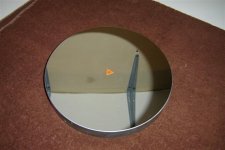
I have a 130mm Dobsonian. I don't use it much. I got it out the other night to look at Saturn and noticed a build up of what looks like dust on the primary mirror.
What is the best way to clean it? Access is my biggest concern down at the bottom of the tube. It looks like you can unscrew it from the base but after replacing it it would surely need alignment.
Any thoughts?
It is this scope...

What is the best way to clean it? Access is my biggest concern down at the bottom of the tube. It looks like you can unscrew it from the base but after replacing it it would surely need alignment.
Any thoughts?
It is this scope...

Sky-Watcher Heritage-130P Flextube Tabletop Dobsonian
First Light Optics - Suppliers of Astronomy telescopes, binoculars and accessories from Skywatcher, Celestron, Meade, William Optics, Atik, Imaging Source, Starlight Xpress, ADM, Moonlite, Catseye, Hutech and others.
www.firstlightoptics.com








